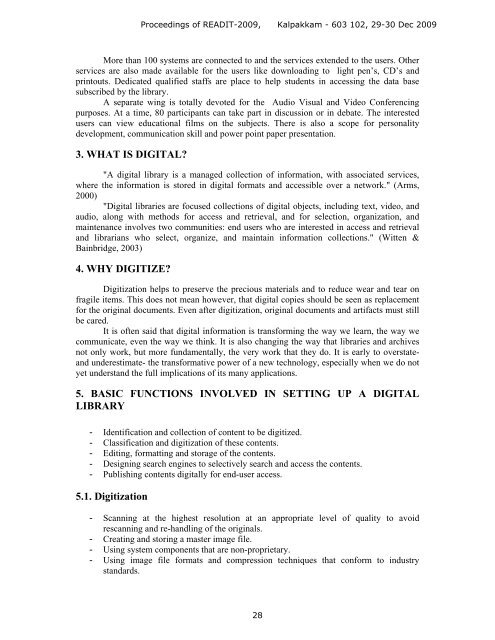READIT - 2009 - Indira Gandhi Centre for Atomic Research
READIT - 2009 - Indira Gandhi Centre for Atomic Research
READIT - 2009 - Indira Gandhi Centre for Atomic Research
Create successful ePaper yourself
Turn your PDF publications into a flip-book with our unique Google optimized e-Paper software.
Proceedings of <strong>READIT</strong>-<strong>2009</strong>, Kalpakkam - 603 102, 29-30 Dec <strong>2009</strong><br />
More than 100 systems are connected to and the services extended to the users. Other<br />
services are also made available <strong>for</strong> the users like downloading to light pen’s, CD’s and<br />
printouts. Dedicated qualified staffs are place to help students in accessing the data base<br />
subscribed by the library.<br />
A separate wing is totally devoted <strong>for</strong> the Audio Visual and Video Conferencing<br />
purposes. At a time, 80 participants can take part in discussion or in debate. The interested<br />
users can view educational films on the subjects. There is also a scope <strong>for</strong> personality<br />
development, communication skill and power point paper presentation.<br />
3. WHAT IS DIGITAL?<br />
"A digital library is a managed collection of in<strong>for</strong>mation, with associated services,<br />
where the in<strong>for</strong>mation is stored in digital <strong>for</strong>mats and accessible over a network." (Arms,<br />
2000)<br />
"Digital libraries are focused collections of digital objects, including text, video, and<br />
audio, along with methods <strong>for</strong> access and retrieval, and <strong>for</strong> selection, organization, and<br />
maintenance involves two communities: end users who are interested in access and retrieval<br />
and librarians who select, organize, and maintain in<strong>for</strong>mation collections." (Witten &<br />
Bainbridge, 2003)<br />
4. WHY DIGITIZE?<br />
Digitization helps to preserve the precious materials and to reduce wear and tear on<br />
fragile items. This does not mean however, that digital copies should be seen as replacement<br />
<strong>for</strong> the original documents. Even after digitization, original documents and artifacts must still<br />
be cared.<br />
It is often said that digital in<strong>for</strong>mation is trans<strong>for</strong>ming the way we learn, the way we<br />
communicate, even the way we think. It is also changing the way that libraries and archives<br />
not only work, but more fundamentally, the very work that they do. It is early to overstateand<br />
underestimate- the trans<strong>for</strong>mative power of a new technology, especially when we do not<br />
yet understand the full implications of its many applications.<br />
5. BASIC FUNCTIONS INVOLVED IN SETTING UP A DIGITAL<br />
LIBRARY<br />
- Identification and collection of content to be digitized.<br />
- Classification and digitization of these contents.<br />
- Editing, <strong>for</strong>matting and storage of the contents.<br />
- Designing search engines to selectively search and access the contents.<br />
- Publishing contents digitally <strong>for</strong> end-user access.<br />
5.1. Digitization<br />
- Scanning at the highest resolution at an appropriate level of quality to avoid<br />
rescanning and re-handling of the originals.<br />
- Creating and storing a master image file.<br />
- Using system components that are non-proprietary.<br />
- Using image file <strong>for</strong>mats and compression techniques that con<strong>for</strong>m to industry<br />
standards.<br />
28

















